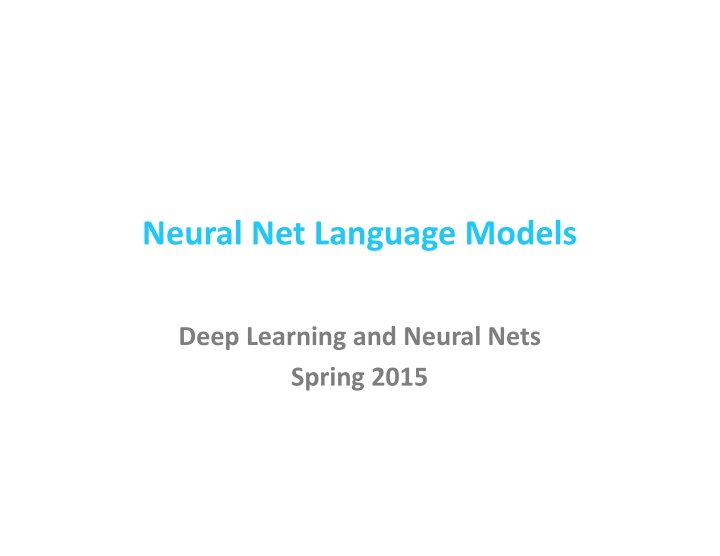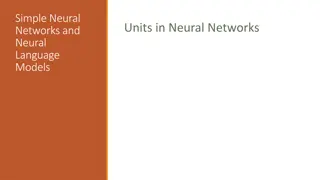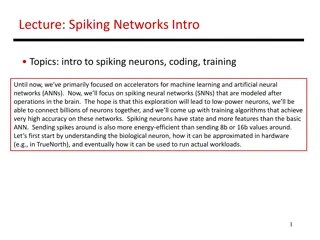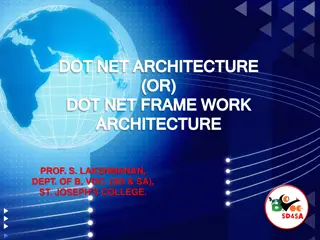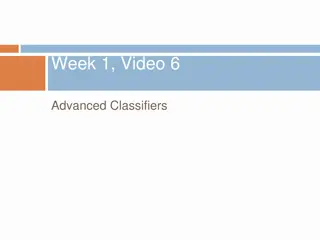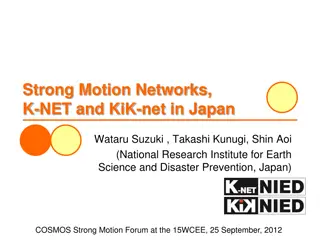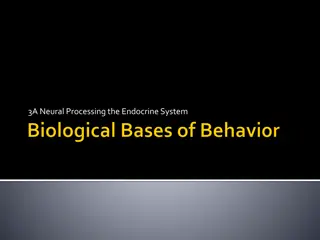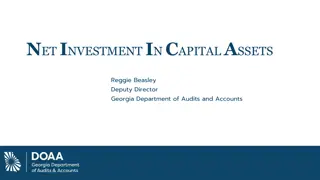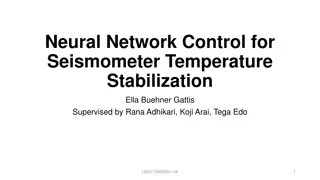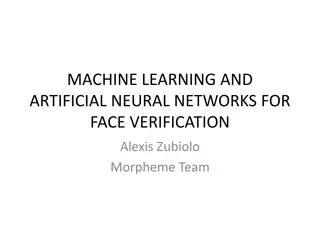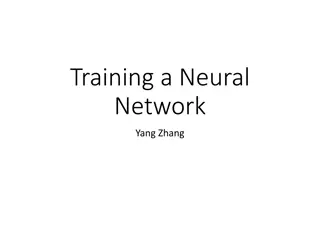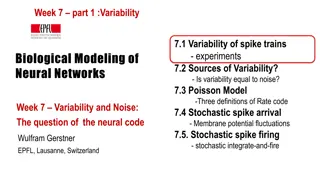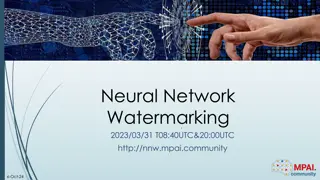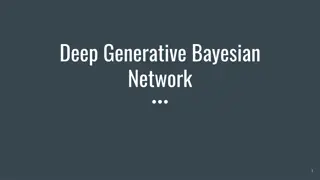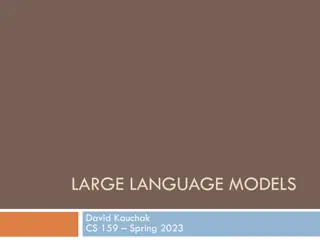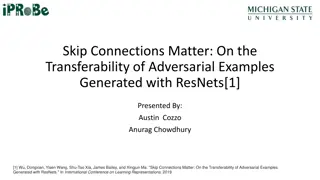Neural Net Language Models & Statistical Models
Neural net language models & statistical language models, n-grams, Markov models, and practical order models. Dive into neural probabilistic language models and scaling properties of models, including performance perplexity. Discover the evolution and challenges of language modeling."
Download Presentation

Please find below an Image/Link to download the presentation.
The content on the website is provided AS IS for your information and personal use only. It may not be sold, licensed, or shared on other websites without obtaining consent from the author.If you encounter any issues during the download, it is possible that the publisher has removed the file from their server.
You are allowed to download the files provided on this website for personal or commercial use, subject to the condition that they are used lawfully. All files are the property of their respective owners.
The content on the website is provided AS IS for your information and personal use only. It may not be sold, licensed, or shared on other websites without obtaining consent from the author.
E N D
Presentation Transcript
Neural Net Language Models Deep Learning and Neural Nets Spring 2015
Statistical Language Models Try predicting word t given previous words in string I like to eat peanut butter and P(wt| w1, w2, , wt-1) Why can t you do this with a conditional probability table? Solution n-th order Markov model P(wt| wt-n, wt-n+1, , wt-1)
N-grams n-th order markov model needs data on sequences of n+1 words Google n-gram viewer
What Order Model Is Practical? ~170k words in use in English ~20k word (families) in use by an educated speaker 1storder Markov model 400M cells if common bigrams are 1000 more likely than uncommon bigrams, then you need 400B examples to train a decent bigram model higher order Markov models data sparsity problem grows exponentially worse Google gang is elusive, but based on conversations, maybe they re up to 7th or 8thorder models Tricks like smoothing, stemming, adaptive context, etc.
Neural Probabilistic Language Models (Bengio et al., 2003) Instead of treating words as tokens, exploit semantic similarity Learn a distributed representation of words that will allow sentences like these to be seen as similar The cat is walking in the bedroom. A dog was walking in the room. The cat is running in a room. The dog was running in the bedroom. etc. Use a neural net to represent the conditional probability function P(wt| wt-n, wt-n+1, , wt-1) Learn the word representation and the probability function simultaneously
Hinton Video Neural probabilistic language models
Scaling Properties Of Model Adding a word to vocabulary cost: #H1connections Increasing model order H2 cost: #H1X #H2 connections H1 Compare to exponential growth with probability table look up
Performance Perplexity geometric average of 1/P(wt | w1, w2, , wt-1) smaller is better Corpora Brown 1.18M word tokens, 48k word types vocabulary size reduced to 16,383 by merging rare words 800k used for training, 200k for validation, 181k for testing AP 16M word tokens, 149k word types vocabulary size reduced to 17964 by merging rare word, ignoring case 14M training, 1M validation, 1M testing
Performance Pick best model in class based on validation performance and assess test performance in perplexity 24% difference in perplexity 8% difference
Model Mixture Combine predictions of a trigram model with neural net could ask neural net to learn only what trigram model fails to predict E = (target trigram_model_out neural_net_out)2 weighting on prediction can be determined by cross validation + neural net trigram model
Hinton Video Dealing with large number of possible outputs
Domain Adaptation For Large-Scale Sentiment Classification (Glorot, Bordes, Bengio, 2011) Sentiment Classification / Analysis determine polarity (pos vs. neg) and magnitude of writer s opinion on some topic the pipes rattled all night long and I couldn t sleep the music wailed all night long and I didn t want to go to sleep Common approach using classifiers reviews of various products bag-of-words input, sometimes includes bigrams each review human-labeled with positive or negative sentiment
Domain Adaptation Source domain S (e.g., toy reviews) provides labeled training data Target domain T (e.g., food reviews) provides unlabeled data provides testing data
Approach Stacked denoising autoencoders uses unlabeled data from all domains trained sequentially (remember, it was 2011) copy input vectors stochastically corrupted not altogether different in higher layers from dropout validation testing chose 80% removal ( unusually high ) Final deep representation fed into a linear SVM classifier trained only on source domain
Comparison Baseline linear SVM operating on raw words SCL structural correspondence learning MCT multi-label consensus training (ensemble of SCL) SFA spectral feature alignment (between source and target domains) SDA stacked denoising autoencoder + linear SVM
Comparison On Larger Data Set Architectures SDAsh3: 3 hidden layers, each with 5k hidden SDAsh1: 1 hidden layer, each with 5k hidden MLP: 1 hidden layer, std supervised training Evaluations transfer ratio how well do you do on S->T transfer vs. T->T training in-domain ratio how well do you do on T->T training relative to baseline
Sequence-To-Sequence Learning (Sutskever, Vinyals, Le, 2014) Map input sentence (e.g., A-B-C) to output sentence (e.g., W-X-Y-Z)
Approach Use LSTM to learn a representation of the input sequence Use input representation to condition a production model of the output sequence LSTMin LSTMout INPUT OUTPUT Key ideas deep architecture LSTMin and LSTMout each have 4 layers with 1000 neurons reverse order of words in input sequence abc -> xyz vs. cba -> xyz better ties early words of source sentence with early words of target sentence
Details input vocabulary 160k words output vocabulary 80k words implemented as softmax Use ensemble of 5 networks Sentence generation requires stochastic selection instead of selecting one word at random and feeding it back, keep track of top candidates left-to-right beam search decoder
Evaluation English-to-French WMT-14 translation task (Workshop on Machine Translation, 2014) Ensemble of deep LSTM BLEU score 34.8 best result achieved by direct translation with a large neural net Using ensemble to recore 1000-best lists of results produced by statistical machine translation systems BLEU score 36.5 Best published result BLEU score 37.0
